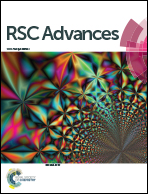Computational understanding of catalyst-controlled borylation of fluoroarenes: directed vs. undirected pathway†
Abstract
In this work, density functional theory (DFT) calculations are performed to understand the origin of the regioselective C–H borylation of aromatics catalyzed by Co(I)/iPrPNP and Ir(III)/dtbpy (4,4-di-tert-butyl bipyridine). The calculation results indicate that for the Co(I)/iPrPNP catalytic system, the undirected pathway is 2.9 kcal mol−1 more favoured over the directed pathway leading to ortho-to-fluorine selectivity. In contrast, for the Ir(III)/dtbpy catalytic system, the directed pathway is 1.2 kcal mol−1 more favoured over the undirected pathway bringing about ortho-to-silyl selectivity. For Co(I)/iPrPNP catalyzed borylation, the undirected pathway which involves steps of ortho-to-fluorine C–H oxidative addition, C–B reductive elimination, B–B oxidative addition, and B–H reductive elimination is favorable due to the electron deficient character of the ortho-to-fluorine C–H bond. For Ir(III)/dtbpy catalyzed borylation, the directed pathway consisting of Si–H oxidative addition, B–H reductive elimination, C–H oxidative addition, B–B oxidative addition, C–B reductive elimination, Si–H reductive elimination is favored over the undirected pathway attributed to the directing effect of the hydrosilyl group. The favourable undirected pathway (ortho-to-fluorine selectivity) for Co(I)/iPrPNP catalyzed borylation and the favourable directed pathway (ortho-to-silyl selectivity) for Ir(III)/dtbpy catalyzed borylation could explain well the experimentally observed ortho-to-fluorine borylation of hydrosilyl substituted fluoroarenes with cobalt catalyst (J. V. Obligacion, M. J. Bezdek and P. J. Chirik, J. Am. Chem. Soc., 2017, 139, 2825–2832) and ortho-to-silyl selectivity with iridium catalyst (T. A. Boebel and J. F. Hartwig, J. Am. Chem. Soc., 2008, 130, 7534–7535).



 Please wait while we load your content...
Please wait while we load your content...